|
Glass
was "in" again, and at a premium. The Artist Collection,
marketed as "tomorrow's antiques", was reaping rewards.
Glass factory rescued by an optically blown wineglass. In the 1980s
BV comes into his own.
Inside
the shabby grinding shop at the Åfors glass factory, in the
mid-eighties, there would very likely be five employees trimming
and polishing miniature versions of, for instance, "Windpipes"
or "Antiqua". Further down the room stood a railway crate
piled with black boxes containing miniatures of "Galaxy"
and "Network". Destination: SAS (Scandinavian Airline
Systems), the high-flying airline company that was flying ever higher.
SAS had a standing order for thousands of miniatures from the Artist
Collection. The black boxes were handed out to all Business, and
First-class passengers.
The recession
of the 1970s was at an end. Political awareness and lack of interest
in luxury goods had now given way to a different attitude. With
the return of a buoyant economy, luxury consumption became a dominant
feature of the decade. The general public, starved of pomp and glamour
for so long, was drawn to the alluring sparkle of crystal. Vino
tinto and the doctrines of Mao were replaced by champagne and 'Business
Week'. The Western world had acquired a taste for the good life.
Glass had a key role in shaping the mythmaking of the legendary
roaring eighties.
The Artist
Collection was now an established trademark. Bertil's ingenious
concept of personalised glass series perfectly matched the mood
of the1980s, with its insistence on individualism. Bertil supplied
the market with a range of artistic collections, which included:
Network, Galaxy, Minos, Apostrophe, Volcano, Pearl, Aphrodite, Rainbow,
Spin, and Centilope.
Network
and Volcano, like Windpipes from the 70s, had their origin in his
art glass production from the 1960s. Both were based on experimentation
in the work-shop. 'Network' was blown in a mould clad with wire
netting, while 'Volcano' acquired its singular appearance from the
use of steel wire. One of the most popular series was 'Galaxy',
consisting of bowls, vases and bottles in varying sizes. On a ground
of crushed white glass a variety of coloured strands in varying
thicknesses were applied to give the impression of trailing galaxies..
An innovation for the 80s was a miniature version of each series
in the Artist Collection, and for the avid collector, a purpose-built
shelf on which to place the small, fist-sized pieces.
But bubbling
champagne requires glasses. So the old idea of the "complete
set of drinking glasses" was revived; wineglasses, beer tankards,
schnapps glasses, whisky tumblers, brandy glasses, and so on. In
the 1980s BV designed some of his best and most popular services.
The story
of how "Chateau" came to be made is one of those good
luck tales. It all began at the end of the 1970s. Bertil was working
all out to finish an optically blown service that would defy mechanical
imitation and which would exploit the special competence of the
glass-blowers at the Johansfors factory, which had been hard hit
by the crisis.
-I was
given the task, at very short notice, of coming up with a bestseller,
Bertil says, remembering his impression of the factory:
... it was like stepping into the equivalent in glass of a clockmaker's
workshop - they made the finest of stems and these amazing carafe
stoppers. They had a genuine feel for the craft and a highly developed
sense of quality. I made up my mind there and then - that's what
I would do, the thing that they were best at - wine glasses.
However, at the preliminary trials things went badly wrong. Quite
contrary to Bertil's expectations, the glass mass just curled and
twisted. He accepted the result however, and in 1981'Chateau' was
launched. The fiasco at Johansfors turned out a winner. Twenty years
on, with a record sales of 12 million glasses, it remains the most
popular wineglass in the world.
-My idea
with Chateau was twofold, says Bertil Vallien. Firstly, I wanted
to make a glass that couldn't be have been made by a machine, and
which was visibly hand-made. I solved this with an optical effect
to the bowl and a long, slender stem.
The other criterion was a beautiful, simple, and multi-serviceable
glass.
Indeed, Chateau is both beautiful and functional. The optical effects
enhance the tinted lustre of the glass, and of its contents.
Chateau
set the tone for Vallien's subsequent services during the 1980s.The
sturdy restraint that dominated in the first 20 years was replaced
by an ethereal delicacy, with thin-walled glass and slender stems.
While working on Chateau, he was simultaneously designing 'Ulrica',
a service without optical effects, and which came out in the same
year. After that he produced a new service every other year: 'Nouveau'
(1983), Grand Cru (1985), and Provence (1987)In Grand Cru the sensual
form is offset by a node at the base of the stem, and contrasts
with the overall impression of feathery lightness.
Povence is characterised by an air-bubble placed in the stem. Both
Provence and Grand Cru are masterpieces of beautiful and functional
design.
Bertil
Vallien's efforts during the 1970s, to avert the threat of mechanisation
made it possible for ordinary people to buy artistic glass at a
reasonable price. In the wider perspective, he has raised professional
standards and the status of the artisans at the glass-factory, and
also created a solid label for Swedish glass. Vallien was a major
actor in the struggle to rescue the Swedish manual glass industry,
by a combination of technical innovation, high artistic levels,
and a rationalised production.
|
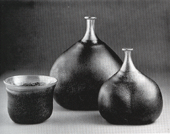
Volcano.

Network.
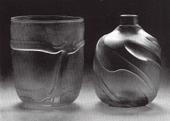
Pearl.
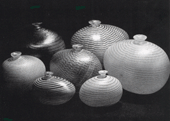
Aphrodite.
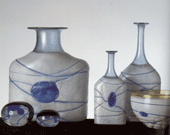
Galaxy
Blue, 1982.

Chateau,
1981.
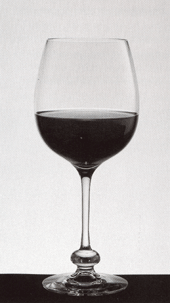
Grand
Cru, 1985.
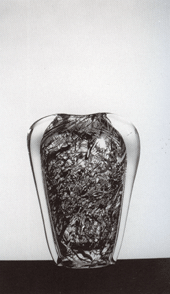
Centilop,
1988.
|


